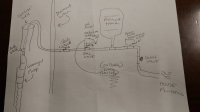Timothy Miller
Drip under Pressure =Expert
Question:
Per the diagram below, I was throwing around the idea of installing a mechanically actuating safety shutoff (that installs on a ball valve) that has an external water sensor that will shut off the ball valve when triggered.
The pressure switch has a low pressure shutoff, (around 20PSI) that would shut off the well pump should this ball valve be closed in the event of a leak. and should I install a check valve before the "emergency shutoff" ball valve???
My thought is that this sensor when detecting water on the floor around my well equipment in the basement, would trigger and close the actuating arm on the ball valve, cutting off the water to the house before the pressure tank and pressure switch, and when the pressure falls below the 20PSI mark, the low pressure safety feature on the pressure switch would shut off the submerged well pump***
OR -should I just place the safety shutoff ball valve on the downstream side of the pressure tank and pressure switch?
Any insight would be most appreciated.
My scribbled diagram:

Per the diagram below, I was throwing around the idea of installing a mechanically actuating safety shutoff (that installs on a ball valve) that has an external water sensor that will shut off the ball valve when triggered.
The pressure switch has a low pressure shutoff, (around 20PSI) that would shut off the well pump should this ball valve be closed in the event of a leak. and should I install a check valve before the "emergency shutoff" ball valve???
My thought is that this sensor when detecting water on the floor around my well equipment in the basement, would trigger and close the actuating arm on the ball valve, cutting off the water to the house before the pressure tank and pressure switch, and when the pressure falls below the 20PSI mark, the low pressure safety feature on the pressure switch would shut off the submerged well pump***
OR -should I just place the safety shutoff ball valve on the downstream side of the pressure tank and pressure switch?
Any insight would be most appreciated.
My scribbled diagram:

